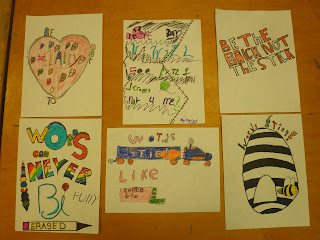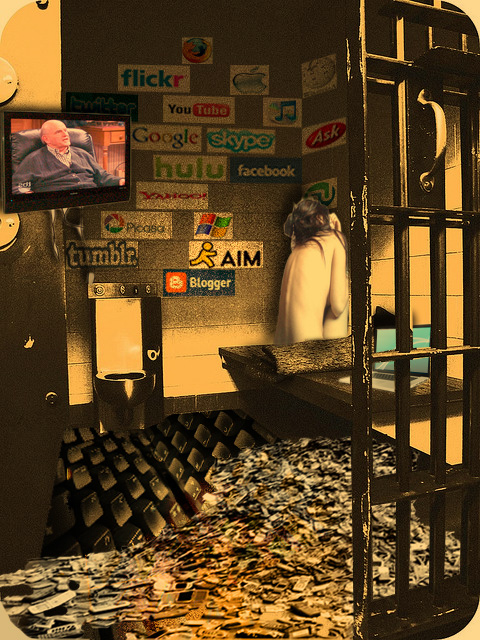Taylor and I taught our lesson "Sell That Logo" to the class on the Tuesday before break. I think it went very well. We spent a lot of time prepping for the class, making sure the flow and transitions would be smooth and simple for the class to understand. We had a lot of information that needed to be told to the students, so any time taken for making groups and getting materials would put us behind. As the students entered the room, there was a sign that instructed them to check out our bulletin board.
This allowed the students to come into the classroom and have an idea of what the project would entail. After they checked out the bulletin board, students were handed a post it with a number, they had to sit at the labeled table with their corresponding number. This was a quick and effective way for students to be placed into groups from the get go and saved us 5 minutes!
When students were seated and the class began, Ms. Henshaw and I showed a slide show that had many different logos and advertisements. We had the class comment on logos they knew and why some advertisements would draw you in more than others. We also spoke about recontextualizing symbols. How these signs we normally see in one place are placed somewhere else.

Somehow along the way, we forgot to maximize our slide show and we found some students were distracted from the main point of our presentation. Next time I use this lesson, I will be sure to use the full screen. After speaking about logos, we brought up the topic of teams and if anyone was on a team. We asked what kind and if there were any different teams people could be a part of, what it means to be part of a team and how to have a successful team. After this class conversation, we informed everyone about a design team, and that where they are seated will be their design team. I think students found this an interesting way to group people together, everyone seemed to be smiling when they looked around at who was in their group. In the back of the room we created posters that described the jobs
Graphic Designer: in charge of final image chosen
Editor: in charge of final words or letters chosen
Team Manager: in charge of keeping the team on track
Project Manager: in charge of presenting logo to class
After presenting these jobs and responsibilities, the groups were handed index cards and had to decide who would be in charge of which job. I think we could have left room for questions if the class had any, instead of rushing into the next step. But the class seemed to catch on to what they were asked of. From here, we went into a class demo. We had all of our materials and slogans cut out and ready for the class to see, saving us time for the students to work.
By simply explaining how we explored through text, color, and shapes, the class quickly saw how they could experiment with their scenarios. We showed a couple more examples that were already created
There was mostly positive feedback about this demo. I found that as a student, often demos were boring and long. Especially if the demo was with a material we know already. So by having everything prepared to simply show experimentation in a couple minutes, students had more time to do the work themselves.
Students were given 15 minutes to sketch, find color combinations, and new slogans for their given scenarios. Ms. Henshaw and I came into class with 8 different scenarios to hand to the class. For example, our demo example was "the company, Gatorade, needs your design team to create a new design for their product. The design will be turned into a decal to be placed on windows all over town. Keep in mind: Old logos and slogans, what colors does Gatorade normally use? Where is it going to be placed?" After giving them out, we figured if there were any issues we would be able to switch them with a new scenario.
After hearing comments from the class, it seems we rushed the creating process a little too much. In the future the students will be allowed to have a day of brainstorming, a day to create logo, and a day to present final products.
Students were allowed 1 minute each to present their logo as a "work in progress." Most students seemed excited to finish enough of their logo to present to the class. They created interesting shapes and used color to grab your eye. After each group presented, another minute was given to the groupsto fill out "client response sheet" and to comment on the logo as if they were the client and were purchasing the final product.
After reading through the student responses on the "client response sheet," many groups had very useful comments that would have been nice to share with the presenting teams. In the future, I would probably have an in progress review like this, and a final review from the class. Allowing for reviews of what the client would want for their design.
Overall I thought this was a very successful lesson and I am very excited to use it in the classroom when I student teach. I will definitely have more days to work on the project and I think as an extension, the students will be able to use digital formats as well. They can create a full ad for their company including full slogans, phrases, dates, and names.
















































